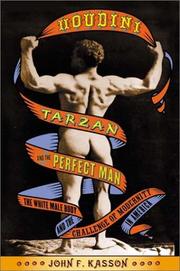
Houdini, Tarzan, and the perfect man
By John F. Kasson
Subjects: Human Body, Houdini, harry, 1874-1926, Human body, social aspects, Men in popular culture, Masculinity in popular culture, Social aspects of the Human body, Popular culture, united states, Tarzan (Fictitious character), Body image in men, Body, Human, Human body, Social aspects, History, Tarzan (fictitious character)
Description: "In his new book, John F. Kasson examines the signs of crisis in American life a century ago, signs that new forces of modernity were affecting men's sense of who and what they really were.". "When the Prussian-born Eugen Sandow, an international vaudeville star and bodybuilder, toured the United States in the 1890s, Florenz Ziegfeld cannily presented him as the "perfect man," representing both an ancient ideal of manhood and a modern commodity extolling self-development and self-fulfillment. With Harry Houdini, the dream of escape was literally embodied in spectacular performances in which he triumphed over every kind of threat to masculine integrity - bondage, imprisonment, insanity, and death. Then, when Edgar Rice Burroughs's Tarzan swung from tree to tree and into the public eye in 1912, the fantasy of a perfect white Anglo-Saxon male was taken further, escaping the confines of civilization but reasserting its values, beating his chest and bellowing his triumph to the world. Kasson's liberally illustrated and persuasively argued study analyzes the themes linking these figures and places them in their rich historical and cultural context. Concern with the white male body - with exhibiting it and with the perils to it - suffused American culture in the years before World War I, he suggests, and continues with us today."--BOOK JACKET.
Comments
You must log in to leave comments.